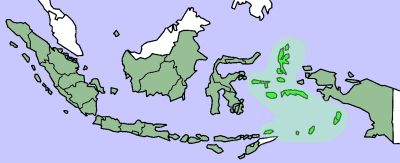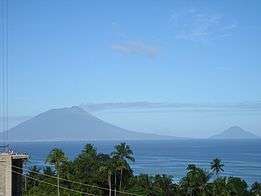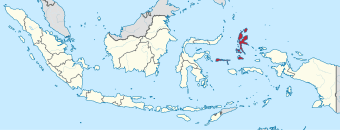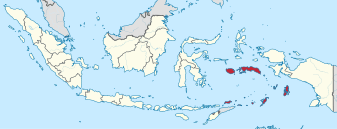Maluku
The Maluku Islands, also known as the Moluccas or the Spice Islands, are a region of Indonesia lying between Sulawesi and Papua. They are divided into North Maluku Province and Maluku Province. Maluku was the first part of what is now Indonesia to be colonized by Europeans, first the Portuguese, then Spanish and finally the Dutch. As a result, many Moluccans have European names.

The islands are still somewhat off-the-beaten track for travelers. Because of their isolation and lack of infrastructure, some of the small islands are a hidden paradise. Transport can be frustrating, but the combination of pristine reefs, tropical beaches, forest-coated volcanoes, centuries-old forts and charming local culture make the effort worthwhile.
Understand

The over 632 islands Maluku are sprawled across a vast expanse of ocean, sitting astride one of the world’s most volatile volcanic belts. Maluku is blessed with incredible sea gardens, idyllic, tropical beaches and rugged, forest-coated volcanic mountains.
These are the famous Spice Islands, which drew Indian, Chinese, Arab and eventually European traders in search of cloves, nutmeg, mace and several other spices that were at the time grown only in these islands. For European traders, these spices were almost as precious as gold. In 1511, the Portuguese built their first fort in the area on the island of Ternate, and cornered the clove trade. The Dutch, who arrived in 1599, mounted the first serious threat to Portuguese control of Maluku’s treasures. Armed conflicts broke out, taking a heavy toll from the islands' populations as well as the rival European powers. When the Dutch finally emerged as victors they enforced their trade monopoly with an iron fist. Whole villages were razed to the ground and thousands of islanders were massacred, especially on the island of Banda.
The British briefly occupied Maluku during the Napoleonic Wars, but Dutch rule was restored in 1814 and it wasn’t until 1863 that the compulsory cultivation of spices was abolished in the province. Now fish and other sea products are Maluku’s major sources of revenue, but nickel, oil, manganese and various kinds of timber also contribute to the province’s wealth.
The main gateway into Maluku is through the provincial capital Ambon, which is served by regular flights to most parts of the archipelago. Air and sea transportation connect the islands with 79 seaports and 25 airports. Roads on many of the islands provide access to the more remote places of interest.
|
Manhattan and Run Run (also known as Pulau Run, Pulo Run, Puloroon, or Rhun) is one of the smallest islands of the Banda Islands, but historically very significant. Back in the early of age of the spice trade, Run and the rest of the Banda islands were the only place in the world to find nutmeg. This created bitter rivalry between the Dutch who had claimed the area and the English who wanted the islands for their own. Then, came the war. The English briefly gained control over Run, but the Dutch later took it back in 1666. Meanwhile, the Dutch colony of New Amsterdam in Manhattan was captured by the English, then renamed New York in September 8, 1664 in honor of the Duke of York (later James II of England), in whose name the English had captured it. The Kingdom of England and the United Provinces of the Netherlands signed the Treaty of Breda (1667) where they agreed to the status quo: the English abandoned Run to the Dutch and kept the island of Manhattan. |
Local people
Prior to the inward migration of Austronesian peoples in the early twentieth century under the Dutch, the inhabitants of Maluku were Melanesian. That inward migration continues today, when Maluku is part of Indonesia. Christianity and Islam are the most common religions. Christianity arrived with the Portuguese and Spanish before Dutch colonisation. The Sultanate of Ternate and Tidore was instrumental in spreading Islam in the north Moluccas, as were Arab traders along the coast of Ambon and its surrounding islands. Indian, Arab, Chinese, Portuguese and Dutch settlers were later added to this Melanesian-Austronesian mix. More recent arrivals include Bugis traders from Sulawesi and Javanese transmigrants.
The people of Maluku are not very familiar with foreigners. Don't be shy, just play along if they ask for a photo.
Most people are bilingual, they can speak their own local language, as well as Indonesian. English isn't widely spoken. People in more developed areas are more likely to understand English than in the isolated areas. A common language in Ambon and nearby Ceram is Ambonese Malay, a Malay-based creole. Local languages include those in Ternate, Tidore and West Makian. More than 130 languages were once spoken across the islands but, due to the increasing use of Indonesian, many of the original languages are now endangered.
Regions
Maluku is administratively divided into two provinces.

- North Maluku Province (Maluku Utara): Covers the northern part of the maluku islands, the new province is home to the "Halmahera rain forests" ecoregion and is home to a number of plant and animal species unique to the islands. Tourism is small, but growing. Most of the islands are unihabited. Prominent islands include Halmahera (Jailolo), the Sula islands, Ternate and Tidore. It is also home to the once mighty Ternate Sultanate, although the Sultan no longer has any political power over Ternate or the region.
- North Halmahera (Halmahera Utara) district consists of the Western half of the northern arm of Halmahera Island plus North Loloda sub-district around the Northern cape and Morotai Island up to the Northeast. The area is sprinkled with beautiful white and black sand beaches which are accessible both by road and boat. Off the coast of North Halamahera there are also numerous small islands, both inhabited and uninhabited, with a lot of excellent snorkeling and swimming.

- Maluku Province, sometimes South Maluku (Maluku Selatan): Covers the central and southern part of the Maluku islands, a bit more developed than its northern counterpart. Its biggest city is Ambon city, which also serves as the main seaport for the province and eastern Indonesia as a whole. Important islands include Ambon island, Aru, Babar, the Banda islands, Buru, Ceram (Seram), Kei, Morotai, the Obi islands and Saparua.
Cities
- 🌍 Ambon - the main city and seaport of Ambon Island and eastern Indonesia in general, capital of Maluku province. Although Ambon experienced sectarian conflicts in the early 2000s, it is a pluralistic city where the inhabitants come from different ethnic backgrounds such as Bugis, Balinese, Javanese, Makassarese, Minang, Flobamora (Flores, Sumba, Alor and Timor tribes), Arabian, Chinese, Dutch, German, Portuguese and Spanish. Also known as Ambon Manise (which means "beautiful" or "pretty"), it is one of the most advanced cities in east Indonesia. Main tourist attractions include beaches and old forts scattered in and around the city.
- 🌍 Masohi - a coastal town on the island of Seram, and the capital of the Central Maluku Regency (Kebupaten Maluku Tengah). Masohi also serves as the headquarters for the Manusela National Park.
- 🌍 Ternate - ex-capital of the North Maluku province on the island of the same name. The current Sultan's Palace, built in 1796, is now partly a museum containing relics from Ternate Sultanates and pre-colonial era.
- 🌍 Tidore — adjacient to Ternate, the island was an independent sultanate, rival to Ternate and an important spice trading center.
- 🌍 Tobelo - a town and also a district on the island of Halmahera.
Other destinations
National Parks
- Aketajawe-Lolobata National Park. Built in 2004, this national park is vital for the survival of numerous endemic bird species in North Maluku. The national park is also designated as home for Togutil tribe. Activities include birdwatching and jungle track. Address: Empat Puluh Road, Sofifi, Maluku Utara Province.
- Manusela National Park. Coastal forest, swamp forest, lowland forest, and montane forest, reaching up to the 3,027-meter-high Mount Binaiya, the national park is surrounded with crystal clear water and tropical landscape. It also has many snorkelling and hiking spots, beautiful coral reefs, underwater caves, and a small resort for visitors to stay. There are 2 villages that are usually used as a gateway to enter the park (as well as the interior of Seram island): Sawai and Wahai. Both villages have a small but growing tourism industry. Address: Kelang 1 Road, Kotak pos 9, Masohi, Central Maluku
Beaches
- Sulamadaha Beach. Located in a village with the same name, Sulamadaha beach is unique because of its black-sanded beach with colorful reefs and clear ocean surrounding it. The price is Rp 2,500 per person (as of 2014). It is about 14 km from Ternate city and can be reached from there by angkot or private vehicles in about 1 hour. Most people snorkel or dive here. In addition, visitors can also enjoy water games like Banana Boat. Everyone is charged Rp 35,000 to try this boat.
- Ora Beach. Located at the edge of Manusela National Park, Seram islands, it offers the chance of staying on top of the clear blue seawater. It's a bit like the Maldives or Bora Bora, but cheaper.
Historical sites and museums
- Fort Belgica. A heritage 17th-century Portuguese fort that was built atop a hill on the southwestern part of the island of Banda Neira, Maluku Tengah. The fort acted as a fortification system for the islands of Banda, which were at the time the only place in the world where nutmeg was produced. In addition to the historical value, this place also has a stunning view. In January 2015, Belgica Fort was added to the UNESCO World Heritage Tentative List as part of the Historic and Marine Landscape of the Banda Islands.
- Fort Victoria. The oldest colonial fort in the city of Ambon, now a tourist attraction. Being situated right in the middle of town, visitors can easily walk their way from Mardika Terminal in the city center. Pattimura, an Indonesian national hero and a symbol of independence, was hanged here.
- Fort Duurstede. A historic 17th-century Dutch fort in Saparua. In 1817 the fort was conquered by local leader Thomas Matulessi, famously known as Pattimura, who had all the soldiers as well as the official Dutch Resident and his family killed. The fort has been restored and is open to visitors. Free entrance.
- Museum Kedaton Sultan Ternate (Palace of the Sultan of Ternate Museum) . A museum of relics from the era of the Sultanate of Ternate. The museum is located in the Village of Sao-sio, Ternate. It was built as the palace for the Sultanate of Ternate.
- Sultan Ternate Mosque. An old mosque built in the Ternate Sultanate era, this is one of the oldest mosque in all of Maluku.
Others
- 🌍 Kei Islands. These small group of islands is a must when visiting Ambon and Maluku. Visitors typically spend their time by getting massages on the beach, snorkelling, fishing, going for long walks on the beach, going to the caves or learning how to cook the Maluku way.
- 🌍 Banda Islands. Small group of ten volcanic islands in the Banda Sea. Until the mid-19th century the Banda Islands were the world's only source of the spices nutmeg and mace, produced from the nutmeg tree. The main town is the historic city of Banda Naira. Banda is a popular destination for scuba diving and snorkelling.
- 🌍 Morotai Island. Forested island lying to the north of Halmahera
Get in
By plane
The two main airports of Maluku are in Ternate (North Maluku) and in Ambon:
- Sultan Baabullah Airport (TTE IATA) on the island of Ternate has regular flights from Manado, Makassar, and Jakarta.
- Pattimura Airport (AMQ IATA) on the island of Ambon has regular flights from Makassar and Jakarta, and also serves flights from several airports in Papua.
- Pitu Airport (OTI IATA) on the island of Morotai in the far north of Maluku is served by flights from Manado.
Flights from Jakarta to Maluku are usually cheaper with a stopover in Makassar or Manado, rather than direct.
By ferry
Several ports, such as Ambon, Banda Naira, Ternate and Tual are served by either Indonesia's national ferry company PELNI, or private companies such as ASDP Indonesia Ferry. There are also smaller, more basic local boats to every significant island in southern Maluku province. The neighbouring Lease Islands and Seram have frequent speedboat and ferry connection with Ambon. There is a car-ferry between Galala in Leitimur and Pokka in Leihitu to save you having to go round the whole bay separating the two peninsulas of Ambon island.
Get around
By boat
Ferries connect major cities and islands in Maluku and is arguably the easiest way (but not the fastest) to travel across the archipelago. For example, a direct trip from Ambon to Ternate may take 18 hours. Other trips across the archipelago may take almost a day (For example, from Saumlaki to Banda Naira). Prices vary across the region and can be more than Rp 200,000 for adults (For example, the Banda Naira-Tual-Dobo route).
By road
Ambon and Seram island in particular has a decent network of roads reaching all of its villages. Buses, bemos and ojeks are the main forms of public transport, though taxis could also be hired. Other places may not have asphalted roads and therefore very hard to access.
See
Since Maluku is an archipelago, there are lots of white sand beaches and corals islands to explore. Some are locally famous, most are either hard to access or unheard of. Because of isolation and the lack of pollution in the region, a lot of them, if not all, are very pristine. This in turn preserves some of the world's last remaining coral reefs. But with tourism continue to develop in the region, there will be plenty of change in the future.
Maluku's colonial history also left behind a large number of historical sites, from old forts to colonial buildings. Most are located in Ambon and Bandaneira, but other historical sites remain scattered through out this little islands. Decades without any significant changes creates some of the best preserved colonial sites in Indonesia.
Do
Eat
The Maluku islands cuisine is rich with seafood. Some dishes look like ordinary Indonesian dishes (with savory taste and a lot of spices), but some are quite unique both in taste and ingredients. An example of the latter is Sagu Woku Komo-Komo, made from sago and fish offal, which is said to taste better than it looks.

Seafood dishes such as the Gohu Ikan (also known among Mollucans as Ternate's sashimi), use more conventional ingredients. It is made out of fresh tuna combined with lemon juice, basil, coconut oil and mashed peanuts. Other seafood dishes include Ikan Kuah Pala Banda (slow-cooked fish soup with spices and a savory-sour taste), Ikan Komu Asar (smoked tuna, usually served with Colo-Colo Sambal), and Kohu-Kohu (a dish made from coconut, anchovies, long beans, and bean sprouts eaten with Kasbi or cassava).
The staple food here, along with the rest of East Indonesia, is papeda or sago congee. It has a glue-like consistency and texture and is commonly eaten with yellow soup made from mackerel, tuna or mubara fish spiced with turmeric and lime. Vegetables such water spinach and bunga pepaya (papaya flower bud vegetables) are also eaten with papeda. The main differences between papeda from Maluku and from Papua are the taste and texture: Maluku's papeda tends to be bland and a bit more chewy than its Papuan counterpart.
Although not as popular as papeda, rice-based dishes do exist in Maluku. One of the most common is Nasi Lapola, a steamed dish made by combining tolo beans, grated coconut and rice. Another rice-based dish is Nasi Jaha, made out of coconut milk, spices, and rice that is steamed in banana leaves.
For dessert (arguably the region's favorite) is Bubur Sagu Ubi, a dessert made from chewy sago and red potatoes (ubi merah) served with coconut milk and palm sugar sauce. The result is a sweet and quite nutritious dessert with a little bit of savor to balance the sweetness of palm sugar. Another dessert, Talam Sagu Bakar, is a dessert made from sago, walnuts, and red beans that are roasted to dry.
Like many other parts of the world, Maluku also has its own coffee drinks. Kopi Sibu-Sibu is a robusta coffee served with a mix of young ketapang seed and mashed cloves.
Drink
Maluku as a region doesn’t have a lot of places specifically designated for nightlife. You might find cafés in bigger city such as Ambon, but that’s about it.
Similarly, just like the rest of Indonesia alcohol is not something you can easily find. Maluku does have its own local liquor called Sopi, but you can’t really buy it since it is illegal to make and purchase Sopi. Sopi is a liquor that has been very popular and ingrained to the general society, made from fermentation of sugar palm sap and has a level of alcohol above 50%. The making of Sopi that produces its distinctive flavor is the addition of Husor root powder and the use of bamboo for distillation. Usually drunk by locals at traditional ceremonies, the production of Sopi is typically done in isolated villages away from authorities.
There are efforts to legalize sopi by some people due to its status as a traditional drink (therefore, part of Maluku's heritage), but so far nothing has been done in fear of "endangering public safety". At least for now Sopi is not something that tourists can buy, so you probably should stay away from it.
Stay safe
Maluku experienced bad riots between 1999 and 2004, but peace has returned and the people are getting on with their lives.
Despite what certain Indonesian embassies and websites might tell you, foreigners no longer need special permits to visit Maluku, and the entire region has been completely safe to visit for years. However, try not to be in Ambon around 25 April, when tensions may flare up due to the anniversary of the separatist RMS movement.
Malaria is also a problem, not only in Maluku but also in many parts of eastern Indonesia. Take preventive drugs and carry along some insect repellent just in case. There aren't many hospitals and health centers in the region (especially the isolated islands), but there are at least 3 hospitals in Ambon city: RSUD Dr. M. Haulussy, Siloam Hospitals Ambon, and Bhayangkara Hospital. There are also risks of other mosquito-related diseases such as Dengue and Zika (According to European Centre for Disease Prevention and Control website, the Maluku islands are part of "WHO Cat. 2" area, meaning moderate risk of infection)
The most common crime for travellers to be aware of is theft. Violent crime is rare, however, it's wise to be extra cautious. The cities in Maluku tend to be small (both in size and population) and the traffic here are less chaotic than Java.
Go next
- To the east of the islands are the Raja Ampat diving site resorts, but there are no connecting commercial flights or ships. Raja Ampat can be accessed by boat from Sorong in West Papua Regency
- Multiple daily flights can be taken to Makassar